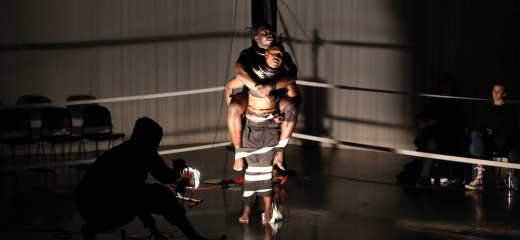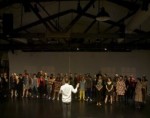
The Ruthless Beauty of Masculinity
by Julius Ferraro
I am completely swallowed up. I can’t call this chaos because it is so intentionally overwhelming. Aggressive club music is blunted by its own volume into incessant beats. As choreographer/performer nora chipaumire* shouts and grunts into her mic, her voice similarly bashes against the top range of the equipment and is just a pulsing agitation, as charming as a train screaming past. The performers beam flood lights directly into our eyes. I’ve never liked clubs or felt at home in places where everyone is shouting. It is so unpleasant I nearly walk out.
This is the prelude to chipaumire’s dense, obsessively choreographed portrait of myself as my father.* The playing area is a boxing ring. chipaumire stands outside of the ring, holding a microphone to her lips, the back of her fist facing us, flexing her bicep to raise it. She wears athletic shoulder pads which come to just above her breasts and a black mesh bra: she is her father, but she is also herself. She soaks up our attention like a leaf does sun, beaming brightly, her physical presence extending in all directions, and she barks into the mic. She points at us as we enter and hollers over our shoulders, like she knows that person right there, like she knows everyone. She is number one.
If sport is where black American men are allowed to showcase their masculinity without being perceived as threats, here is Mike Tyson, here, Mohammed Ali, here, paragons of black masculinity. Here, too, though, is every over-confident man I’ve ever met who has used his self-love as radioactive weapon: here is the frat boy, here is the favorite son, the beautiful high school football star, the golden boy. Charming, magnetic, grotesque, doomed.
Or maybe I include the frat boy and the football star to excuse how I personally—a straight white artistic-type American male—feel threatened, cowed, diminished by this display of overt hyper-masculinity, black or not. And maybe I feel threatened not only by overt masculinity but specifically by the black masculinity displayed here.
How I would react differently to this piece if there were white bodies on stage instead of black ones? Americans, regardless of race, tend to perceive more danger from black bodies. Can I extract my reaction from the fact that this is not just a show about masculinity, but a show about black masculinity?
Later. The lights are dim and the music is blistering. Pape Ibrahima Ndiaye, also known as Kaolack, who is tethered to chipaumire, rolls around the stage, pulling down the barriers. Shamar Watt runs and performs insane leaps, landing inches away from the toes of the audience. chipaumire, standing coolly with her mic, says “black man, you better run. Black president, you better run.”
The three of them stand together in a line. “This is how you become a black African man,” says chipaumire. “Learn to swag,” she answers herself, and the three of them lean low, bending their knees deeply and sway, grinning, arms extended upwards with the mics. “Pretend that you know everyone” is another, and I remember her manner at the beginning of the piece, as we entered. Are these stereotypes, or are they true representations of masculinity—or of performed masculinity?
Later, Kaolack crouches deep, his weight below his knees, and swings his whole body to step from foot to foot. He rises up, letting his head fall below his rolling shoulders which bring him to a vertical stance. Completely straight now, he pauses, and, with his arms out to his side, swivels his hips small degrees left to right. It reads as an effeminate dance that nevertheless radiates power.
chipaumire crowds up on Kaolack. “Show me your moves!” she shouts in his face. He curls up, timidly, and she punches the air around his head. “We have a shy one,” she shouts at him, “a pussy.” They occupy, in this moment, two extreme sides of masculinity.
chipaumire never met her father. She says in this video, “The only thing I know about my father is my mother’s […] silence about him.” He does not exist, and he does; he is both conceptual and real. The world chipaumire and her collaborators are working in is so dense, convoluted, and exhausting, it is difficult to pick apart where rhetoric, stereotype, and dream end and reality begins. It is difficult to see where fear ends and tenderness begins.
It certainly does not start out tender: the immediate sensation is its oppressive aesthetic, crowding and bullying, blinding and deafening with its overly performative masculinity. chipaumire intentionally leads with this, at once celebrating the charisma of the domineering male figure and building a cloud of horror around him—real chaos, real atmospheric oppression.
From this cloud emerges a complex and sensitive portrayal of the weakness behind the bombast, the soft target that swings the fists. I simultaneously fall for and despise chipaumire’s father, the same as I can defend and am disturbed by my reaction to him. What comes to the surface is a man who is penned in by his own performance, dominated by the need to dominate, aggressive because he is vulnerable—a deeply problematic masculinity that is somehow separate from the person performing it. What becomes most effective in this piece is that they do not run from the one in order to portray the other, but instead blister the stage in the attempt to give us both.
portrait of myself as my father, nora chipaumire, Philadelphia Museum of Art, 2600 Ben Franklin Parkway, September 23-24, fringearts.com/portrait-of-myself-as-my-father/.
*The title of the show, and the name of the choreographer, are presented all in lowercase type.
By Julius Ferraro
September 30, 2016








